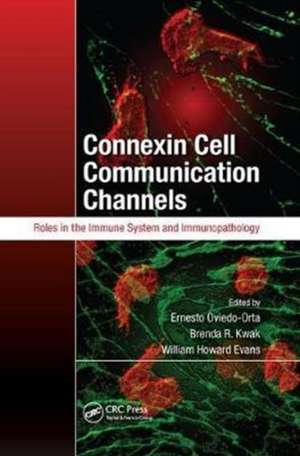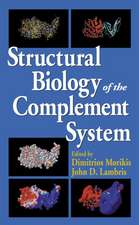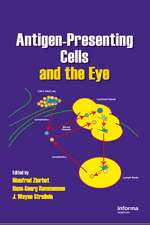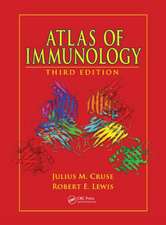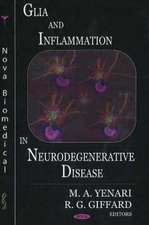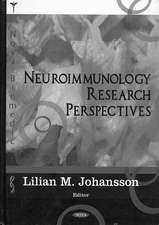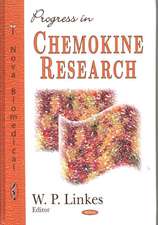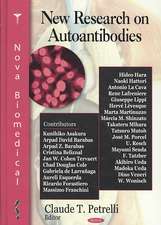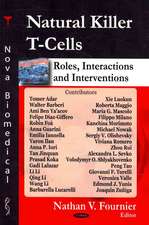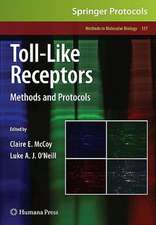Connexin Cell Communication Channels: Roles in the Immune System and Immunopathology
Editat de Ernesto Oviedo-Orta, Brenda R. Kwak, William Howard Evansen Limba Engleză Paperback – 15 noi 2017
The book first provides a historical overview of the discovery of these membrane channels in cells and tissues of the immune system. It describes their general molecular and biological characteristics and examines how they participate in the evolution, organization, function, and regulation of leukocytes, as well as their interaction with other tissues.
The next section examines immunologically related disease scenarios where gap junctions and connexins have been shown to play a fundamental role. The contributors explain how gap junctional communication participates in the establishment and maintenance of immunological properties such as antibody and cytokine production, as well as lymphocyte immune surveillance in both physiological and pathological conditions. The book explores the most important technical approaches used and how they have been specially adapted to answer key biological questions particular to the mobile nature of leukocytes. It also describes the most recent understanding of how gap junctions and connexins participate in antigen recognition, cross-presentation, lymphocyte activation, and in the assembly and function of the immunological synapse.
Finally, the book focuses on the latest progress made on translating the knowledge gained to specific treatment modalities. Topics in this section include approaches for reducing scarring and cardiac arrhythmia, combating inflammation in the central nervous system, and enhancing epithelial tissue repair. A comprehensive view of achievements in this promising field, the book will inform and update specialists, clinical practitioners, and those studying the potential for commercial applications.
| Toate formatele și edițiile | Preț | Express |
|---|---|---|
| Paperback (1) | 370.25 lei 6-8 săpt. | |
| CRC Press – 15 noi 2017 | 370.25 lei 6-8 săpt. | |
| Hardback (1) | 1046.24 lei 6-8 săpt. | |
| CRC Press – 22 mar 2013 | 1046.24 lei 6-8 săpt. |
Preț: 370.25 lei
Preț vechi: 492.29 lei
-25% Nou
Puncte Express: 555
Preț estimativ în valută:
70.86€ • 73.70$ • 58.50£
70.86€ • 73.70$ • 58.50£
Carte tipărită la comandă
Livrare economică 15-29 aprilie
Preluare comenzi: 021 569.72.76
Specificații
ISBN-13: 9781138199507
ISBN-10: 1138199508
Pagini: 380
Ilustrații: 54
Dimensiuni: 156 x 234 mm
Greutate: 0.45 kg
Ediția:1
Editura: CRC Press
Colecția CRC Press
ISBN-10: 1138199508
Pagini: 380
Ilustrații: 54
Dimensiuni: 156 x 234 mm
Greutate: 0.45 kg
Ediția:1
Editura: CRC Press
Colecția CRC Press
Cuprins
Immunology and Cell Biology. Communication in the Immune System by Connexin Channels. Gap Junctions and Connexins in the Hematopoietic-Immune System: Structural Considerations. Approaches for Studying the Role(s) of Gap Junctions in the Immune System. Gap Junctions in Antigen-Presenting Cells. Connect the Immune System: Roles of Gap Junctions in Antigen Presentation and T Cell Activation. Gap Junctions and Connexins in the Immune Defense against Tumors. Inflammation and Inflammatory Diseases. Connexins in Atherosclerosis. Connexins in Lung Function and Inflammation. Effect of Oxidative Stress on Connexins in the Vasculature. Regulation of Gap Junctions and Cellular Coupling within the Microvasculature in Response to Acute Inflammation. Impact of Microglial Activation on Astroglial Connexin Expression and Function in Brain Inflammation. A Role for Connexins in Inflammatory Disorders of the Epidermis. Connexin-Based Therapeutical Approaches in Inflammatory Diseases. Translating Basic Research on Cx43 Gap Junctions into Therapies for Reducing Scarring and Cardiac Arrhythmia. Connexin-Based Therapeutic Approaches to Inflammation in the Central Nervous System. Enhancing Epithelial Tissue Repair and Reducing Inflammation by Targeting Connexins. Index.
Notă biografică
Ernesto Oviedo-Orta received his MD from the Havana Medical School in Cuba where he also specialized in clinical immunology. During his postgraduate specialist training, he engaged in vaccine research related to diverse infectious agents and diseases, including measles and hepatitis C. Dr. Oviedo-Orta’s Ph.D. research work in Cardiff, UK, focused on the role of gap junction intercellular communication in the immune system. His work continued in this area both in Bristol and Guildford, UK, but with special attention to immune regulation. Dr. Oviedo-Orta is currently a Clinical Sciences Expert at Novartis Vaccines & Diagnostics, Siena, Italy, where he is a medical and scientific advisor supporting new and ongoing projects in vaccine research and clinical development.
Brenda R. Kwak studied at the University of Amsterdam, the Netherlands, where she also obtained her PhD. Dr. Kwak carried out her PhD research work focusing on the regulation of cardiac gap junction channels using a dual patch−clamp approach. She then continued her work for several years as a postdoctoral fellow at the University of Utrecht, the Netherlands. After moving to the University of Geneva, she focused on the vascular system, first in the endothelium at the Department of Morphology, and later on the regulation of major histocompatibility complex class II (MHC-II) in the context of atherosclerosis at the Department of Internal Medicine—Cardiology. On receiving a professorship from the Swiss National Science Foundation in 2003, she established an independent research group in the same department to dissect the role of Cxs in atherosclerosis. She is now associate professor to both the Department of Pathology and Immunology and to the Department of Internal Medicine—Cardiology at the University of Geneva and focuses more broadly on the role of Cxs in cardiovascular physiology and pathology, work that still includes atherosclerotic disease but also restenosis, ischemia−reperfusion injury of the heart, platelet activation, thrombosis, and the lymphatic system.
William Howard Evans, PhD, is professor of medical biochemistry in the Institute of Infection and Immunity at Cardiff University Medical School, United Kingdom. His interest in intercellular communication via gap junctions spans from 1972 and his group has studied many facets of the structure and function of these Cx-based channels in a variety of normal and pathological situations. His recent studies focus on addressing the roles of Cx channels in translational medicine. This has involved the design and development of small Cx mimetic peptides that block the operation of these channels. He also studies their use in addressing cardiac pathology.
Brenda R. Kwak studied at the University of Amsterdam, the Netherlands, where she also obtained her PhD. Dr. Kwak carried out her PhD research work focusing on the regulation of cardiac gap junction channels using a dual patch−clamp approach. She then continued her work for several years as a postdoctoral fellow at the University of Utrecht, the Netherlands. After moving to the University of Geneva, she focused on the vascular system, first in the endothelium at the Department of Morphology, and later on the regulation of major histocompatibility complex class II (MHC-II) in the context of atherosclerosis at the Department of Internal Medicine—Cardiology. On receiving a professorship from the Swiss National Science Foundation in 2003, she established an independent research group in the same department to dissect the role of Cxs in atherosclerosis. She is now associate professor to both the Department of Pathology and Immunology and to the Department of Internal Medicine—Cardiology at the University of Geneva and focuses more broadly on the role of Cxs in cardiovascular physiology and pathology, work that still includes atherosclerotic disease but also restenosis, ischemia−reperfusion injury of the heart, platelet activation, thrombosis, and the lymphatic system.
William Howard Evans, PhD, is professor of medical biochemistry in the Institute of Infection and Immunity at Cardiff University Medical School, United Kingdom. His interest in intercellular communication via gap junctions spans from 1972 and his group has studied many facets of the structure and function of these Cx-based channels in a variety of normal and pathological situations. His recent studies focus on addressing the roles of Cx channels in translational medicine. This has involved the design and development of small Cx mimetic peptides that block the operation of these channels. He also studies their use in addressing cardiac pathology.
Descriere
Plasma membrane-associated channels known as gap junctions, along with their protein building blocks—connexins—have an important functional role in a range of immunological processes. This volume assembles and synthesizes four decades of the most important research carried out in this field. The contributors focus on the latest progress made on translating the knowledge gained to specific treatment modalities. Topics include approaches for reducing scarring and cardiac arrhythmia, combating inflammation in the central nervous system, and enhancing epithelial tissue repair. The book will inform and update specialists, clinical practitioners, and those studying the potential for commercial applications.
